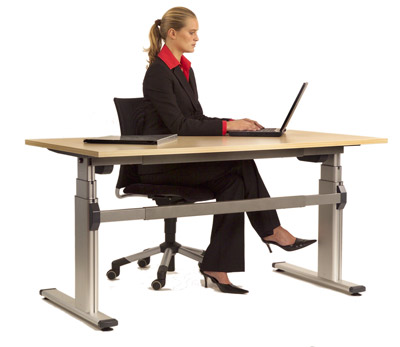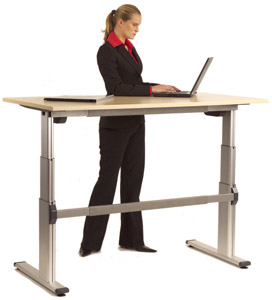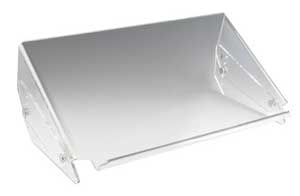Setting up a back friendly Office
Whilst we are often asked about the correct set-up of a back friendly office, the question is usually phrased along the lines of – “What office chair should I have?” Whilst seating is important, a correct approach to the problem of a back friendly office office is much broader.
The problem
The fundamental problem with office life is that it is all too often inactive. As creatures, we were simply not designed to be in one position for prolonged periods of time. Our evolution was such that we were designed to potter about looking for berries and occasionally run away from lions. Once we had found the berries, we would sit down to eat them. There is nothing inherently good about sitting, standing, pottering or running – it is simply that they are different. Our evolution has been such that whilst we had found the food, we would sit hunched down over it, so as not to be seen by the lion whilst we ate it. By contrast, when standing, it is extremely difficult to stand in a slumped position for any prolonged period of time, because we were designed at that point to be looking out at the lions and seeking the berries. There is nothing inherently good or bad about standing or sitting – it is simply that they are different. If you maintain either position for a prolonged period, you will cause problems.
Imagine the spine in its seated, hunched position. The pressure on the intervertebral discs will go through a certain point, and likewise the pressure on the facet joints at the back of the spine will also be felt at a certain point on the joint surface. The muscle fibres will be at a particular length and under a particular tension, as will the ligaments. If you sat on one buttock on a hard bench for a long time, you would not be surprised to have a sore bottom. The spinal equivalent of wriggling is to get up, at which point a different part of the disc will take the pressure, and likewise the joints. The muscle fibres would be at a different length and under differing tensions. Whilst moving from one position to another nourishes the spine, remaining in one position wears and exhausts it. Guardsmen get just as much back pain as secretaries, though one acquires it standing, and the other sitting.
So, if the problem is inactivity, the solution is to make your office an active space – the hamster needs a wheel.
How you achieve an active office will differ, depending upon the nature of your work, and the environment in which you are doing it. Here are some things that you might consider.
The back friendly office solution
An adjustable desk
A common practice in Scandinavia is to have desks that are adjustable in their height. The user simply presses a couple of levers under the desk, and it raises up to standing height. Thus, these individuals spend part of their day sitting down, and the other part standing up. If you are running your own office, or have a particularly flexible firm, you may be able to obtain one of these items. It will change your life


The telephone
 If the desk is unachievable, and you spend a considerable amount of time on the telephone, then a wire-free telephone headset can be useful.
If the desk is unachievable, and you spend a considerable amount of time on the telephone, then a wire-free telephone headset can be useful.
The idea is to stand whenever you are on the telephone, preferably looking out the window at a distant object, and to sit whenever you are not on the telephone. Clearly, if you lead your life with a PC and e-mail, this method will be of little use.
Two chairs
 If the telephone and the desk are not solutions for you, then your answer does not lie in one magnificent chair, but in having two different chairs of contrasting design. On a standard office chair, you will inevitably sit in the traditional way. As soon as you become engrossed by whatever it is that you are looking at – be it paper or a PC screen – you will hunch forward to concentrate. It is, as mentioned above, an irresistible force of nature. For those of you who are deskbound, a kneeling chair or saddle seat offers the ability to hold the spine in an upright posture whilst seated. If you attempt to slump on a kneeling chair or saddle seat, you simply fall off the front. Thus, the spine is held in the standing position. The same can be achieved by sitting on a Swiss ball. Take the opportunity to do your core muscle exercises.
If the telephone and the desk are not solutions for you, then your answer does not lie in one magnificent chair, but in having two different chairs of contrasting design. On a standard office chair, you will inevitably sit in the traditional way. As soon as you become engrossed by whatever it is that you are looking at – be it paper or a PC screen – you will hunch forward to concentrate. It is, as mentioned above, an irresistible force of nature. For those of you who are deskbound, a kneeling chair or saddle seat offers the ability to hold the spine in an upright posture whilst seated. If you attempt to slump on a kneeling chair or saddle seat, you simply fall off the front. Thus, the spine is held in the standing position. The same can be achieved by sitting on a Swiss ball. Take the opportunity to do your core muscle exercises.
The idea is to spend an hour on one chair and then an hour on another. The kneeling chair and saddle seat are not an alternative to your office chair, for if you used continuously, they are no better than any other chair. It is the changing from one style to another than help
Design in activity
If you have to post lots of letters, then place the envelopes on the opposite side of the room. If you attend meetings with different individuals, try to split them up throughout the day. If you dictate letters, try standing up whilst you do it.
Pairing
It is very important that the height of the chair is matched to your height. It should be such that your knees are at right angles and the back is upright, so that your hip to spine angle is at right angles. The desk should be high enough to allow for you not to bend forwards to lean on it. If you work with a PC, the position of the screen will determine how you sit, almost irrespective of the design of the chair. As soon as you concentrate, you will move your head forwards to have a comfortable focal length for your eyes. Thus, in general, the screen needs to be high and quite near in order to keep you sitting relatively upright.
Plinth
 If you spend a considerable amount of time looking at paperwork, a plinth that allows the paper to be displayed at an angle is useful. The greater the number of degrees the paper is angled towards you, the fewer degrees you have to bend your neck to look at it.
If you spend a considerable amount of time looking at paperwork, a plinth that allows the paper to be displayed at an angle is useful. The greater the number of degrees the paper is angled towards you, the fewer degrees you have to bend your neck to look at it.
An ergonomic mouse
For some, prolonged periods of fine movement cause neck tension and arm pains. A large mouse that encourages big movements reduces that. Similarly, big keyboards that encourage the hands to be held somewhat further apart than would typically happen with a small keyboard encourage the shoulders to be held open.
Avoid laptops
The worst possible arrangement is a laptop. The keyboard is narrow, so you have to hunch the shoulders in order to get the hands close enough together. In addition, the screen is connected to the keyboard, so you have to hunch down in order to see it. The classical pain induced by a laptop is a burning sensation just inside the shoulder blade. Either use a properly set up desktop, or have an independent screen, mouse and keyboard whilst putting the laptop on a box to elevate its screen.
Conclusion
The problem for most office workers is that they spend too long in one position. The solution does not lie in the perfect chair, for there is no such thing. Certainly, some chairs are better than others, but you are simply not designed to sit all day. One way or another, you need to become more active whilst in the office. Once you have built in activity to your day, then set about organising the contents of your desk to encourage a good posture. All of these items are weak winds, though taken together may well get your ship sailing in the right direction.